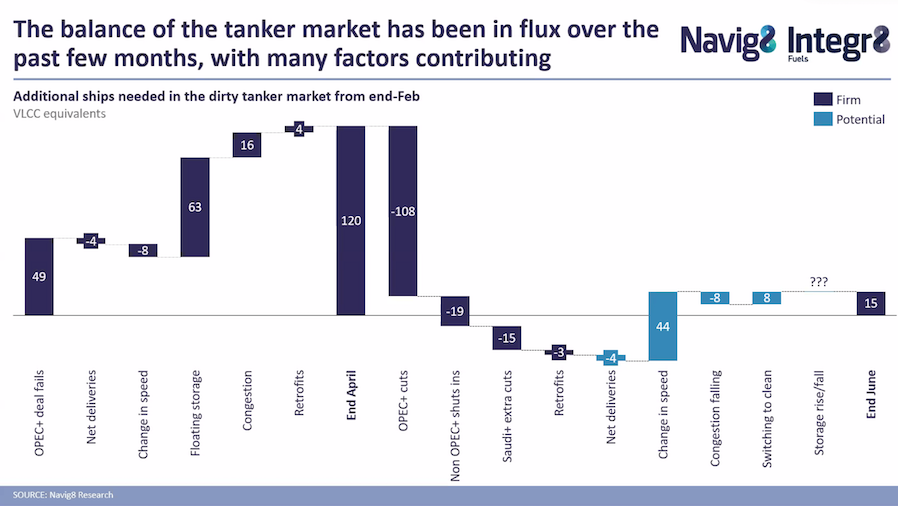Floating storage duration to offset Opec crude cuts, says Navig8
Floating storage has soared to the highest level in records going back to 2009. Some 240m barrels are tracked on 225 tankers, according to data from Lloyd’s List Intelligence
‘Long and slow drawdowns of floating storage will place a wet blanket on earnings for an extended period’ — Navig8 Group research director Paul Marsh
NAVIG8 Group has weighed into the debate over tanker supply and demand for the remainder of 2020, forecasting global crude production cuts will remove the equivalent of 132 very large crude carriers from the market over the next two months.
A rebound in tanker rates to levels as high as $250,000 per day was unlikely, according to Paul Marsh, research director at the company, which owns and operates a fleet of some 130-plus chemical, product and crude tankers.
Floating storage, an oil price war and port congestion all boosted demand for additional tankers by the equivalent of 120 VLCCs from the end of February until the end of April, Mr Marsh said in a webinar.
But he estimated that the April accord drawn up by the Organisation of the Petroleum Exporting Countries now meant 108 fewer VLCCs would be needed after April.
Some 9.7m bpd in production cuts was agreed over May and June by Opec and 10 other countries to help rebalance the market.
Oil producers that did not sign the agreement would also account for cuts equivalent to 19 VLCCs, Mr Marsh said. Extra curbs from the Middle East Gulf removed a further 15 tankers, the presentation said.

If the global crude fleet reduced speed, that would potentially increase demand for VLCCs by 44 ships, while congestion, newbuilding deliveries and tankers switching to clean trading also fed into the Navig8 supply and demand equation.
The scale and pace at which floating storage would unwind over the next six weeks was the one unknown, Mr Marsh said. If this happened slowly “the tanker market will be in a place of relative strength” by the end of June.
Floating storage has soared to the highest in records going back to 2009. Some 240m barrels are tracked on 225 tankers according to data from Lloyd’s List Intelligence. That is based on aframax to VLCC-sized vessels, laden and at anchor for at least 20 days.
The figure has increased from 163m barrels last month, amid rising congestion and delays at ports and a shortage of land-based storage for surplus crude.
Spot earnings for VLCCs rose to as much as $260,000 per day in mid-March before easing back to just over $40,000 by the end of last week. The oil price contango has narrowed in past weeks, which reduced the economics that drove floating storage.
The contango structure, in which the spot price is lower than the future price, allows traders to profit from buying and storing for later sale at a profit.
There was an “outside chance” of a second rebound in rates, Mr Marsh said. That was “unfortunately” tied to secondary lockdowns, or if Opec agreements to curb supply failed, which would depress spot oil prices and lift storage demand.
“Long and slow drawdowns of floating storage will place a wet blanket on earnings for an extended period,” Mr Marsh said. “During this time, I think we will see many owners of vintage tonnage throwing in the towel, with a significant lack of ordering (of new tankers) taking place, which leads to a very promising supply picture.”
With floating storage ‘normalised’ and rising tanker demand, there will be “a sustained period of strong earnings for the tanker market”, he said, without giving a time frame.
Mr Marsh also forecast that the oil market was heading for a period of “prolonged backwardation”, in which the spot price is trading higher than the future price. “It’s not what the tanker market wants, but it is inevitable,” he said.
Navig8’s crude scrapping estimates were put at the equivalent of 99 VLCCs, with 11 “highly likely” and 88 “possible” in 2020. That was seen rising to 252 VLCC equivalents, including 170 possible the following year. This was based on the age, survey date and whether ballast water treatment systems mandated by international convention had been installed yet.
Product tanker scrapping was estimated at 76 for 2020 with 16 “highly likely” and 197 in 2021, including 54 in the “highly likely” category.

